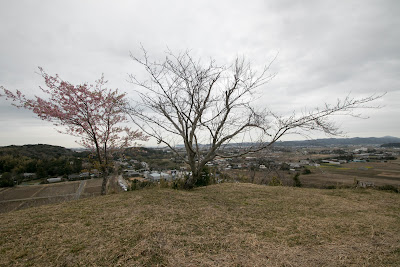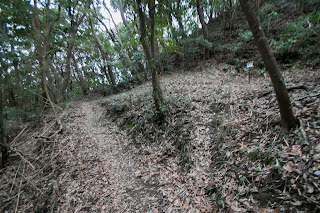Inamura Castle
-History of peninsular brave (2) Coup d'etat erased from history-
Overview
Name: Inamura castle (Inamura-jo)
Alias:
Place: Ine Tateyama city, Chiba
Type: Hill Castle
Built: 15th century?
Remaining remnants: Clay walls and moats
Title:
Brief History
Continued from Part 1
Inamura castle (稲村城) is built over Shiroyama hill which is about 30 meter height from hillside, in the middle part of current Tateyama city. Castle site is a middle point of Tateyama plain which spreads over 5 kilometer east and westward, and this point is a meeting point to horizontal road which connects east shore and west shore of Boso peninsula, and southward road toward Shirahama area at the tip of the peninsula.
Today city area spreads western coast side of the plain, but formerly current city area was a muddy area with large inlet. On the other hand, east half of the plain was a rich rice cultivation area with solid ground and rivers as water source, and ancient administrative office of Awa province (tip of Boso peninsula) was placed near castle site.
In addition to this, Castle site was directly connected to Tokyo Bay by inlet of Takigawa river. Considering these geographical conditions, it was a suitable point to manage Awa province from the viewpoint of agricultural production and communication.
Landing of Satomi clan to Awa province
In the middle of 15th century, Kanto region had been quite unstable situation between the conflict of Kamakura Kubo, which was a relative of Muromachi Shogunate and was appointed as a representative of Shogunate in Kanto region but shows the attitude of independence, and Kanto Kanrei which was the aide of Kubo and kept loyalty to Shogunate.
In 1455, Shigeuji Ashikaga (1438-1497) who was Kamakura Kubo at that point purged Noritada Uesugi (1433-1555) at Kanto Kanrei, and both side entered endless battle over 30 years. As Awa province was held by Kanto Kanrei side local lords, and quite close to Kamakura city where was the base of Kamakura Kubo at the opposite of narrow Uraga Straight.
To seize Awa province, Kamakura Kubo sent Satomi clan, one of their important retainer, to the province. Yoshizane Satomi (1412-1488), who was the first leader of Satomi clan as warlord, landed to Shirahama area at the tip of Boso peninsula where was a good port connecting inner sea transportation of Tokyo Bay and outer sea transportation in Pacific Ocean, and started to seize the province.
Fighting and coordinating with existing local lords such as Anzai clan, Tojo clan or Yamashita clan, Satomi clan gradually grew their power and territory toward north from their first main base Shirahama castle (Chiba prefecture). Second leader Shigeyoshi Satomi (1448-1505) has no record and his existence is uncertain, but by the end of 15th century Satomi clan grasped whole part of Awa province. It is said that Inamura castle was built around this time.
Growth to strong local lord
Yoshimichi Satomi (1481-?), the eldest son of Yoshizane Satomi or Shigeyoshi Satomi, emerged as a strong local lord in the history. Kamakura Kubo which was the master of Satomi clan was pushed out from Kamakura city in the conflict with Uesugi clan, and moved to Koga castle (Ibaraki city) then named as Koga Kubo Highness. Koga Kubo aimed to seize east half of Kanto region,
On the other hand, Mariyatsu Takeda clan which was the lord of Mariyatsu castle (Chiba prefecture) hoped expansion and placed Yoshiaki Ashikaga (?-1538), the relative of Koga Kubo, as Oyumi Kubo Highness at Oyumi castle (Chiba prefecture). Due to the geographical closeness, Yoshimichi Satomi belonged to this Oyumi Kubo Highness and continued expansion.
Yoshimichi ordered his young brother Sanetaka Satomi (1484-1533) as a commander of Kanaya castle (Chiba prefecture), which was at the border of Kazusa province (middle part of Boso peninsula) and Awa province just below of Nokogiri-yama mountain. Sanetaka coordinated with strong local lord Masaki clan, which might be a branch family of Miura clan and managed coast navy.
The territory of Satomi clan expanded along the coast of Tokyo Bay, toward middle part of Boso peninsula, and economic interest from marine transportation increased. Yoshimichi strengthened his situation as the governor of Awa province, and donated Tsurugaya Hachimangu Shrine at Tateyama city as the leader. Inamura castle might be expanded along with the development of Satomi clan.
Structure of Inamura castle
Castle spreads C letter like curved ridge of the hill. Central area of the castle is a trapezoidal one of about 50 meter long. Huge clay wall at southwestern line built by residual of digging ground protects direct climbing to the area, along with watchtower might exist over it. Entrance into the area has a complex gate with buffer area.
A narrow ridge spreads toward northeast from central has many defense facilities such as dry moat, corridor area or clay bridge. To cover low height of the hill, many terraces were built at the slope from top to hillside.
Contrary to this, a ridge spreads toward south has no remarkable defense facility except for one dry moat, but considering terraces built at this part it might be used as a part of the castle. Road from hillside arrives at the south edge of this area, where is a saddle point of the ridge, Ahead of this part there are many flat areas over the hill but it is not clear a part of the castle or farming ground.
Confrontation to Hojo clan
In 1516, Hojo clan, a growing warlord of Odawara castle (Kanagawa prefecture) ruined Miura clan of Miura peninsula, opposite of Uraga Straight from Satomi clan. Furthermore, Hojo clan captured Edo castle (Tokyo Metropolis) from Ogigayatsu Uesugi clan in 1524, and adjoined to the territory of Oyumi Kubo Highness. Now Hojo clan became the threat of Satomi clan.
In response to this, Yoshitoyo Satomi (?-1534), son of Yoshimichi and who was praised as wise lord from a priest, attacked Kamakura city held by Hojo clan directly crossing Uraga Straight, with Yoshitaka and navy of Masaki clan. But during this battle Yoshimichi wrongly burned Tsurugaoka Hachimangu Shrine, which was the spirit of samurais in eastern Japan.
Yoshitoyo lost his reputation, and Satomi clan had to contribute to reconstruction lead by Hojo clan. Looking at this situation, Hojo clan tried to coordinate with Sanetaka Satomi and change the leader of Satomi clan, to separate it from Oyumi Kubo Highness.
Purge and counter attack
Among this situation, Yoshitoyo Satomi purged Sanetaka Satomi and Michitsuna Masaki (?-1533), the leader of Masaki clan in 1533. Next Yoshitoyo attacked survived Yoshitaka Satomi (1507?-1574) and Tokishige Masaki (1313-1561), son of Sanetaka and Michitsuna, but Yoshitaka allied with Hojo clan and made counter attack.
As Masaki clan belonged to Sanetaka with its navy, Yoshitoyo could not stop reinforcement army from Hojo clan. Yoshitoyo fell into inferior situation once escaped to Kazusa province and asked reinforcement army from Mariyatsu Takeda clan and returned to Awa country, but suffered fatal defeat before Yoshitaka at the battle of Inufuse and died in the battle. Inamura castle was abolished after the battle.
After this internal conflict, Yoshitaka Satomi seized the leader position of Satomi clan. But even though his father was purged, this was a clear revolt to the leader of Satomi clan. Furthermore, Yoshitaka once asked assistance to Hojo clan, the fatal enemy of Satomi clan, soon Yoshitaka broke with Hojo clan for the response to internal conflict in Mariyatsu Takeda clan and restarted the conflict against Hojo clan.
Coup d'etat erased from history
To conceal these improper facts, Yoshitaka Satomi changed the story as follows. The age of Yoshitoyo Satomi became much younger, and because of immature Sanetaka Satomi once looks after the leader position instead of Yoshitoyo. Sanetaka thought to return the position to Yoshitaka after his grow up, but Yoshitaka thoughtlessly purged Sanetaka then Yoshitaka had to avenge his father’s death.
Yoshitaka intentionally deleted the record of Yoshitoyo and earlier period, and as Yoshitaka brought the peak period to Satomi clan, this new story remained as a formal history of Satomi clan until recently. But reconciling remaining limited evidences to the record of other clans, what happened at that time becomes clear.
Now no building remains but structure of the castle well remain over the hill. There is no long line of clay wall which is the common feature of the castles of Satomi clan after Yoshitoyo Satomi. Even though no record remains, the size and structure of the castle clearly shows it was a main base of Satomi clan at the period of Yoshimichi Satomi and Yoshitoyo Satomi, which was took over by Yoshitaka Satomi and erased from history.
Continue to Part 3
Access
30 minutes drive from Futsu-Tateyama Doro Expressway Tomiura interchange.
Related Castles
Shirahama Castle -History of peninsular brave (1) Mysterious landing to peninsula-
Katsuura Castle - History of peninsular brave (3) Ally or subordinate?-



























































































































































































































No comments:
Post a Comment